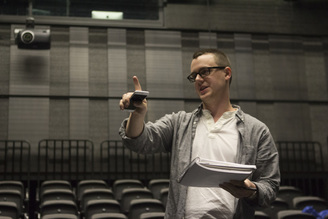Performance, Prison Strike, Zombie: Steve McQueen's Hunger and the 'Reflection Machines'
Nicholas Fesette
Abstract
The hunger striker and the zombie are powerful figures of the performance of resistance in a world increasingly affected by the normalization of the logic of mass imprisonment. The hunger strike has a long history and continues to find purchase in the popular imaginary, evidenced in prisons and detainment centers around the world. Director Steve McQueen’s 2008 film Hunger provides for this phenomenon a visual aesthetic by dramatizing the 1981 Irish Republican Army hunger strike that led to the deaths of Bobby Sands and nine others in HM Prison Maze. Concurrently, “zombie culture” has in recent years exploded in popularity. The living dead are a productive metaphor for the imprisoned, and multimedia franchises like The Walking Dead render explicit this connection between the carceral and the undead—in this case by posing the prison space as a commodity of security in a dystopia overrun with zombies. The proliferation of the undead is even effected in activist engagement in the streets, as Occupy protestors don rags and fake blood in “zombie walks.” Performers of hunger strikes and zombie can be read as what Rebecca Schneider calls “reflection machines,” which paradoxically cast back onto the ideological stage its own illegitimacy; the performers embody their figural subjugation within and to that ideology as decaying, disappearing bodies and reflect this embodiment back onto the powers-that-be. Might reading the performative figures of the hunger striker and the zombie problematize neoliberal ideals at the threshold of the prison? The imprisoned hunger striker radically performs zombie, transforming himself into the figure of the cadaver that he always already is while imprisoned and testifying to the undead qualities of citizen-subjectivity in an era of “hyper-incarceration.”
The hunger striker and the zombie are powerful figures of the performance of resistance in a world increasingly affected by the normalization of the logic of mass imprisonment. The hunger strike has a long history and continues to find purchase in the popular imaginary, evidenced in prisons and detainment centers around the world. Director Steve McQueen’s 2008 film Hunger provides for this phenomenon a visual aesthetic by dramatizing the 1981 Irish Republican Army hunger strike that led to the deaths of Bobby Sands and nine others in HM Prison Maze. Concurrently, “zombie culture” has in recent years exploded in popularity. The living dead are a productive metaphor for the imprisoned, and multimedia franchises like The Walking Dead render explicit this connection between the carceral and the undead—in this case by posing the prison space as a commodity of security in a dystopia overrun with zombies. The proliferation of the undead is even effected in activist engagement in the streets, as Occupy protestors don rags and fake blood in “zombie walks.” Performers of hunger strikes and zombie can be read as what Rebecca Schneider calls “reflection machines,” which paradoxically cast back onto the ideological stage its own illegitimacy; the performers embody their figural subjugation within and to that ideology as decaying, disappearing bodies and reflect this embodiment back onto the powers-that-be. Might reading the performative figures of the hunger striker and the zombie problematize neoliberal ideals at the threshold of the prison? The imprisoned hunger striker radically performs zombie, transforming himself into the figure of the cadaver that he always already is while imprisoned and testifying to the undead qualities of citizen-subjectivity in an era of “hyper-incarceration.”
| etudessept2015fesette.pdf | |
| File Size: | 275 kb |
| File Type: | |


